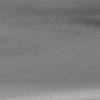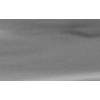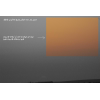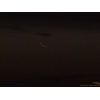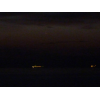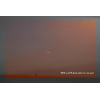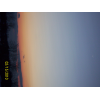Visibility of Rabee' Al-Awwal Crescent 1431 AH
- When to Observe Rabee' Al-Awwal Waxing (NEW) Crescent ?
- Rabee' Al-Awwal Waxing (NEW) Crescent Observation Results
- The OFFICIAL First Day in Different Countries
- When to Observe Safar Waning (OLD) Crescent ?
- Safar Waning (OLD) Crescent Observation Results
When to Observe Rabee' Al-Awwal Waxing (NEW) Crescent ?
The geocentric conjunction (Geocentric New Moon) will occur Inshalla on (Sunday 14 February 2010) at 02:51 UT.
Sighting the new crescent on (Sunday 14 February 2010) and (Monday 15 February 2010) is shown in the below graphs using the program Accurate Times by Mohammad Odeh according to Odeh criterion. Where:-
- It is impossible to see the crescent from the areas located under the red color. Because either the Moon on this day sets before the Sunset and/or the topocentric conjunction occurs after the Sunset.
- The crescent is expected to be seen by optical aid only from the areas located under the blue color.
- The crescent is expected to be seen by optical aid from the areas located under the magenta color. In these areas the crescent could be seen by naked eye if the atmospheric conditions are superb and the observer is experienced.
- The crescent is expected to be easily visible by naked eye from the areas located under the green color.
- The crescent cannot be seen from uncolored areas, even though the Moon sets in these locations after the Sunset and the topocentric conjunction occurs before the Sunset, but the Moon is not sufficiently illuminated in order to be seen as crescent even by optical aid.
- Kindly notice that the below graph shows the possibility of seeing the crescent from areas between 60 degrees north of Equator down to 60 degrees south of Equator.

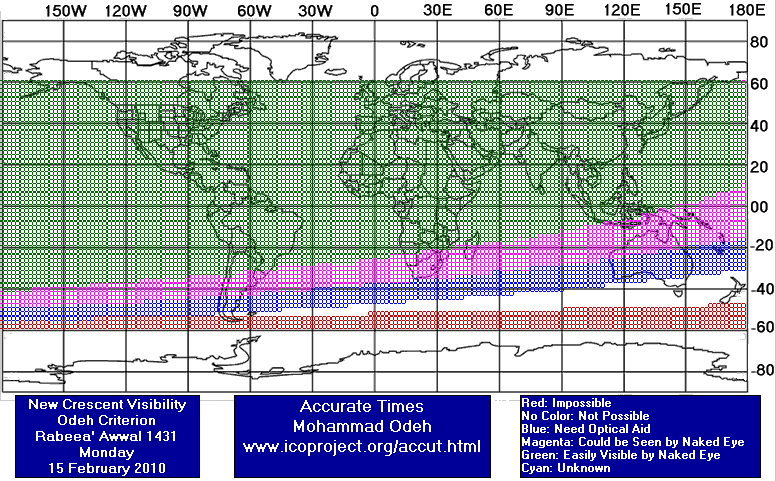
According to the Universal Hejric Calendar (UHC), which is based on the calculated crescent visibility, the start of this month in the Eastern Region will be on Monday 15 February 2010 and in the Western Region will be on Monday 15 February 2010. Kindly notice that the UHC is a pre-calculated calendar, which adopts a certain criterion to start the new Hejric month. Your country/organization might adopt different criterion to start the new Hejric month. So it is highly advised to read the UHC website before giving any judgment.
- Results of seeing the crescent, and the first day of the month in different countries will be added here Inshalla as we receive the reports from ICOP's members. If you wish to be a member in ICOP, or to know more about it, kindly click here.
Rabee' Al-Awwal Waxing (NEW) Crescent Observation Results
Sun 14 February 2010
Germany
Eng. Martin Elsaesser said: "I hiked up a 1700m mountain through the snow to get above the cloud layer, which topped at about 1650m. Conditions up there were excellent and the view of isolated peaks sticking out of the clouds was breathtaking. I lugged two telescopes up that mountain: one for visual observation (80mm diameter refractor, 20x or 40x) and a second one (70mm refractor, focal length 400m) with a b/w video-camera attached, also a power-supply and notebook to drive the camera. Both scopes were precisely aligned to show the same field of view. I hoped to use the camera to find the crescent and then have a chance of seeing it visually, too. Venus was found immediately after sunset, Jupiter too. Moving the scope from venus towards the crescent was simple and soon the camera view showed the crescent, exactly as expected: A nice horizontal arc, some 14 hours after conjunction at an elongation of 6.5°. So far, so good. Alas, despite trying for another 30 minutes until the crescent set, i could NOT see the crescent visually with the 80mm telescope (at 20x or 40x), despite looking at the correct spot, as proven by the live-image. Focus might have been slightly off and i probably also misjudged the size of the crescent i was looking for in the field of view. So, any visual observation at these elongations obviously is EXTREMELY difficult and will require the very best conditions, optimized equipment and thorough preparation. Still, a great experience all around. "
Nigeria
Mr. Qamarudeen Muhammad said: "We attempted to sight the new Hilal of Rabiul Awwal on the Sunday 14 evening but it was not visible here in Lagos. In a phone chat with Research officer of National Moonsigthing Committee,it was confirmed that they were unable to sight New Hilal as well(observation Location is at atop of National Mosque confrence centre,Abuja). Also in phone chat with Brother Simwal Jubril(Kaduna) he was not able to search for new Hilal."
Pakistan
Mr. Alam Sultan said: "On my request, nearly 2 hundred persons (members of the moon-sighting committees of our institute "JAMIA-TUR-RASHEED" + my friends + their companions) tried to sight the moon at more than 27 places all over Pakistan but the moon could not be sighted, as it was astronomically expected tonight. In Sindh, Balochistan and many places of Punjab, weather was clear but in Sarhad and many places of Punjab, it was fully cloudy. Note 1: Chairman of central official moon sighting committee of Pakistan mufti munee-bur-Rahman told me on my mobile phone that as he also did not receive any positive report countrywide therefore he announced officially that Monday 15 February is 30th Safar and Tuesday 16 February 2010 is 1st Rabee-ul-Awwal 1431 in Pakistan. Note 2: After some days, inshaallah, a detailed report of this observation in Urdu will be available at www.esnips.com/web/moonnewsofjamiaturrasheed "
Saudi Arabia
Mr. Bander Albotehy said: "لم أتمكن من رصد الهلال نظرا لقربه من الأفق مع سوء حالة الغلاف الجوي قرب الأفق"
Somalia
Mr. Abdulaziiz Hagi Bashiir said: "Here in Garoowe the crescent was not found due to the hazy conditions on the western horizon. I've also talked to someone in Xarfo and Bosaso, but the result was the same "the crescent was not seen"... "
South Africa
Tanzania
Mr. ZZ-Hamza Rijal said: "On Feb 14, Sunday, the sky was clear but Hilal was not sighted in tiny island of Zanzibar, therefore we complete 30 days and Tuesday 16 will be the first day of Rabiul Awal. "
United Kingdom
Eng. Qamar Uddin said: "On Sunday, 14 February 2010 (29 Safar 1431 AH) many of us from different parts of UK have tried to sight the crescent moon (Hilal) of Rabi-ul Awwal 1431 AH after sunset, but there were no positive sighting reports received, as many places were totally cloudy and others partly cloudy. There were no reliable sighting reports from any countries in the East of UK either. Therefore, the Ulama have decided that the lunar month of Safar 1431 AH will have 30 days and 1 Rabi-ul Awwal 1431 AH in UK will be from Tuesday 16 February 2010, Insha-Allah."
United States
Dr. Javad Torabinejad said: "This evening (Sunday, February 14, 2010), two of us, equipped with two pairs of binoculars (7X50) and (10X50), attempted sighting the moon in Blacksburg Virginia with no success. We arrived at the sighting location well before sunset (sunset: 6:00 pm EST) to mark the sunset location and stayed till Jupiter (one of the indicators) disappeared behind the clouds several minutes before moonset (moonset: 6:47 pm EST). The western sky was partly cloudy. We first sighted Venus and then Jupiter and looked for the crescent in relation to the positions of the two planets according to the Sky and Telescope's interactive sky chart and the Abrams planetarium's sky calendar. We scanned the clear patches with no success."
Mon 15 February 2010
Algeria
Mr. Hocine Chikh Aissa said: ""(02) observers were present in bOULANOUAR station with one binoculars. (07X50) The new crescent of Rabee Awwal was not seen by naked eyes and by a binocular, The sky was Totally cloudy. Aide malid nabaoui said. "
Bangladesh
Mr. ABM Ruhul Hassan said: "The Crescent of Robiul-Awwal Shareef was seen from Sunamgonj district of Bangladesh.The sky was clear. 16 Feb is the first Rabil-Awwal Shareef."
Germany
Japan
Mr. Ibrahima Lo said: "It rained at Tsukuba. It was not be possible to see the crescent by naked eyes (see the photo)."
Jordan
Malaysia
Mr. Kassim Bahali said: "The Hilal of RabiulAwwal 1431 was seen at Khawarizmi Observatory. The western sky was cloudy but the hilal was seen between the cloud. My wife first spotted the hilal by naked eye at 19:52 followed by my sighting later by my son and daughters. We last spotted the hilal at 20:02."
Nigeria
Pakistan
Mr. Alam Sultan said: "Alhamdolillah, We easily sighted the moon in Karachi and in many parts of country, as it was expected tonight astronomically. I requested many members of the moon-sighting committees of our institute "JAMIA-TUR-RASHEED" and many of my friends all over Pakistan to sight the moon. Many hundred Persons easily sighted the moon in 3 provinces (Balochistan, Sindh and Punjab). As it was fully cloudy or rainy in province Sarhad therefore there is no positive report from there. Note : After some days, inshaallah, a detailed report of this observation in Urdu will be available at www.esnips.com/web/moonnewsofjamiaturrasheed "
Saudi Arabia
Mr. Bander Albotehy said: "تم رصد الهلال من المنزل بالعين المجردة مع بعض الصعوبة لتواجد بعض السحب جهة الغرب"
Somalia
Mr. Abdulaziiz Hagi Bashiir said: "The crescent was seen in many places here in Puntland State of Somalia. I wish you all a happy and blessed MAWLID AL NABI "PBUH".."
United States
Dr. Javad Torabinejad said: "This evening (Monday, February 15, 2010), using a pair of (7x50) binoculars, I sighted the crescent in Blacksburg, Virginia. The western horizon was mostly clear. We arrived at the sighting location prior to the sunset (sunset, 6:01) and soon after the sun disappeared behind the clouds. First I sighted Venus at 5:52 and then the moon at 5:53. Right after, the crescent was sighted with naked eye. At 6:01 pm, the elevation of the crescent was about 15 degrees above the horizon. The crescent horns were approximately on 4:00 and 7:30 O'clock with 6:00 O'clock at the lower part of the crescent towards the horizon."
The OFFICIAL First Day in Different Countries
Mon 15 February 2010
1 . Indonesia
2 . Malaysia
3 . Nigeria
4 . Saudi Arabia
5 . Somalia
Tue 16 February 2010
1 . Bangladesh
2 . Pakistan
3 . South Africa
4 . Tanzania
5 . United Kingdom
When to Observe Safar Waning (OLD) Crescent ?
The geocentric conjunction (Geocentric New Moon) will occur Inshalla on (Sunday 14 February 2010) at 02:51 UT.
Sighting the OLD crescent on (Sunday 14 February 2010) and on (Saturday 13 February 2010) is shown in the below graphs using the program Accurate Times by Mohammad Odeh according to Odeh criterion. Where:-
- It is impossible to see the OLD crescent from the areas located under the red color. Because either the Moon on this day rises after the Sunrise and/or the topocentric conjunction occurs before the Sunrise.
- The crescent is expected to be seen by optical aid only from the areas located under the blue color.
- The crescent is expected to be seen by optical aid from the areas located under the magenta color.. In these areas the crescent could be seen by naked eye if the atmospheric conditions are superb and the observer is experienced.
- The crescent is expected to be easily visible by naked eye from the areas located under the green color.
- The crescent cannot be seen from uncolored areas, even though the Moon rises in these locations before the Sunrise and the topocentric conjunction occurs after the Sunrise, but the Moon is not sufficiently illuminated in order to be seen as crescent even by optical aid.
- Kindly notice that the below graph shows the possibility of seeing the crescent from areas between 60 degrees north of Equator down to 60 degrees south of Equator.
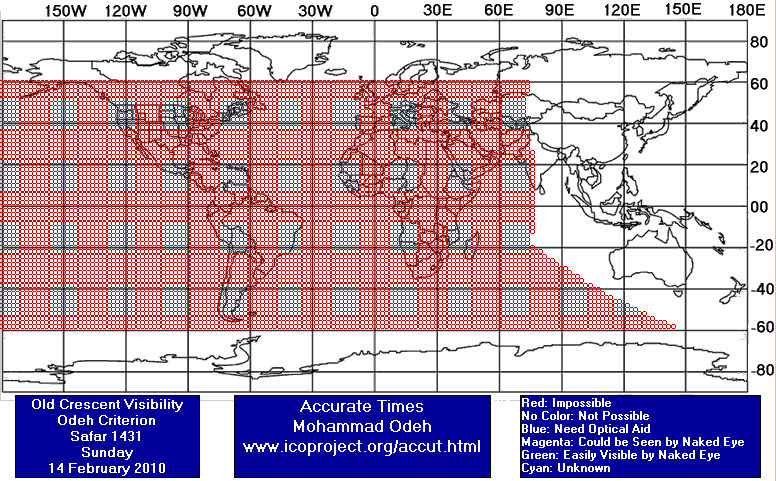
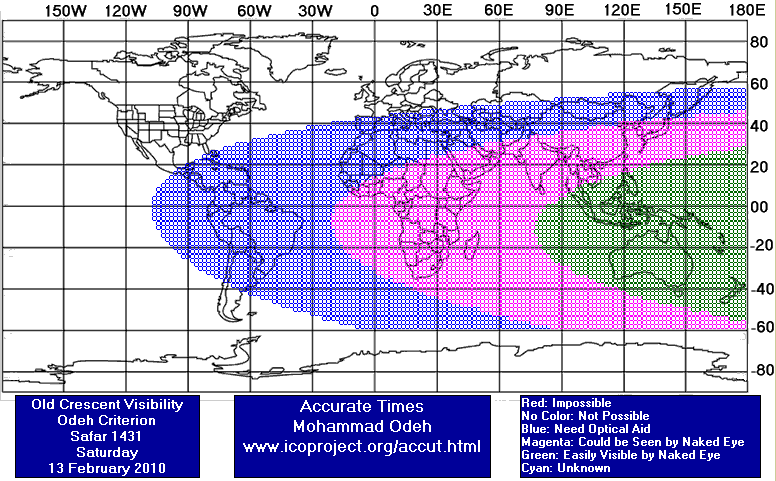
Safar Waning (OLD) Crescent Observation Results
Sat 13 February 2010
United Kingdom
Eng. Qamar Uddin said: "I have tried to sight the waning crescent of Safar 1431 AH before sunrise today (Saturday 13 February 2010) from York, but it was not seen - the eastern horizon was partly-cloudy."
United States
Mr. Jim Stamm said: "I was NOT able to see the crescent, even through a telescope. Very clear looking straight up, but more mushy as I looked closer to the horizon. Bands of haze and water vapor prevented me from using stars to precisely position the scope. I had to sweep at 2 degrees altitude, without results."
